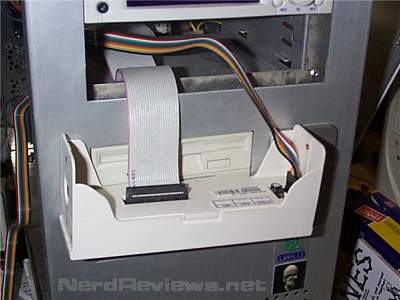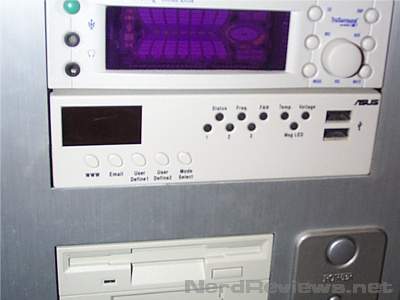ASUS iPanel Review
By Bones (Ed T. Toton III)
Sept 20, 2002
(Review unit not supplied; purchased for use)
DESCRIPTION
ASUS has long been known for making quality mother boards, and
more recently a variety of other PC components as well. But one
device that they make is often ovrelooked, and even those who
build computers for a living using ASUS parts often don't know
about the existence of the iPanel.
The ASUS iPanel is a device that fits into a standard 5.25 drive
bay, and monitors various aspects of your system. It works only
with iPanel-enabled ASUS motherboards, but is capable of providing
a lot of feedback about your system.
This review is currently covering the iPanel Basic, though it may
be updated at a future time to include details about the iPanel Deluxe.
Installing the iPanel is a breeze. As you can see in the pictures
below, it slips into a drive-bay, and connects with two ribbon cables.
The larger ribbon is the data cable, which connects to the motherboard
through a specialized iPanel pin-block. The smaller ribbon is optional,
as it simply connects the two front-facing USB ports that this device
provides.
You'll notice in the pictures below that the thin USB ribbon is
multi-colored and doesn't match the larger cable. This is because
I had to replace the cable that originally came with the device. I
used the iPanel successfully for about a year with the original cable,
but upon upgrading to a new motherboard, I found that the USB ribbon
was no longer long enough. ASUS was wise to supply a reasonably long
data cable, and simultaneously brain-dead to make the USB cable only
20" long. Since the newer boards put the USB pin-headers further towards
the back of the computer, even with the iPanel in the lowest bay in
my case, the cable fell about 2 inches short. And I must say, finding
replacement USB 10-pin ribbons is no easy task. Most people would likely
end up learning to crimp ribbin cable by hand.


Once installed, you'll notice right away that when your computer is booting,
it displays 2-digit hexidecimal POST codes (Power On Self Test). If your
system hangs during the boot process, the last code displayed can indicate
where the problem may be. Other stats are also available after the system
gets past the POST phase. Using the "mode select" button, you can cycle
through displaying numbers corresponding to fan speeds, CPU temperature,
motherboard temperature, BUS speed, processor speed, and supplied voltages.
In addition, the iPanel has programmable hot-keys just below the LED display,
which can be customized using the included software.
OBSERVATIONS
I've been using the iPanel Basic for over a year now, and in many cases
the information has been invaluable to me, especially since the system
I had it in for most of that time had some bizarre boot-related quirks,
and I watched the processor gradually die. Being able to tell at a glance
whether the computer is failing to boot, or whether it's about to overheat,
are very useful features for someone who wants to overclock their computer,
or have one that is quirky enough that it requires a certain amount of
hand-holding.
Newer motherboards and newer BIOS revisions for older boards often
support auto-updating. By itself, the iPanel only receives a number
when you press the "mode select" button, and will not update it in
real-time. With auto-updating enabled, you can have the information
displayed updated usually in increments of 8, 16, or 32 seconds. This
is a nice feature that works well for typical uses such as web-browsing,
e-mail, etc, but becomes a nuisance when playing a game. The iPanel
updates interrupt the entire system momentarily, causing a very noticable
and annoying effect when playing games or watching animation. Since the
auto-update feature usually can only be toggled in the BIOS menu at boot-time,
most people will likely leave this feature turned off.
Costing only about $30, these devices are a cost effective way to set up
basic monitoring on your computer. However, since the information is
very narrow in scope, and the iPanel only works with iPanel-enabled ASUS
motherboards, it will tend to have a limited audience. Most every-day
users will find little use for it, but it can be a nice addition for
overclockers, gamers, and power-users... not to mention those of us who
just like having more switches, lights, and knobs to play with.
Features:
- 2 Front-facing USB ports
- Temerature Monitor (CPU, MB)
- Fan Monitor (CPU, Chassis, etc. 3 max)
- Voltage Monitor
- Speed Indicator (BUS, CPU, etc)
- Displays Boot Codes
- Hot-Keys
Pros:
- Useful diagnostic and monitoring information
- Easy to install
- Inexpensive
- Hot-keys are programmable
- Adds front-facing IO ports
Cons:
- Doesn't auto-update unless BIOS setting is used.
- Auto-updating has large performance impact.
- Only works with specific motherboards from ASUS.
- USB ribbon cable is too short for some computers.
The "Deluxe" version, which we have yet to try, has all of the features
of the "Basic" model, plus a front-facing serial port and front-facing audio
jacks.
ASUS Motherboard Accessories Page

|